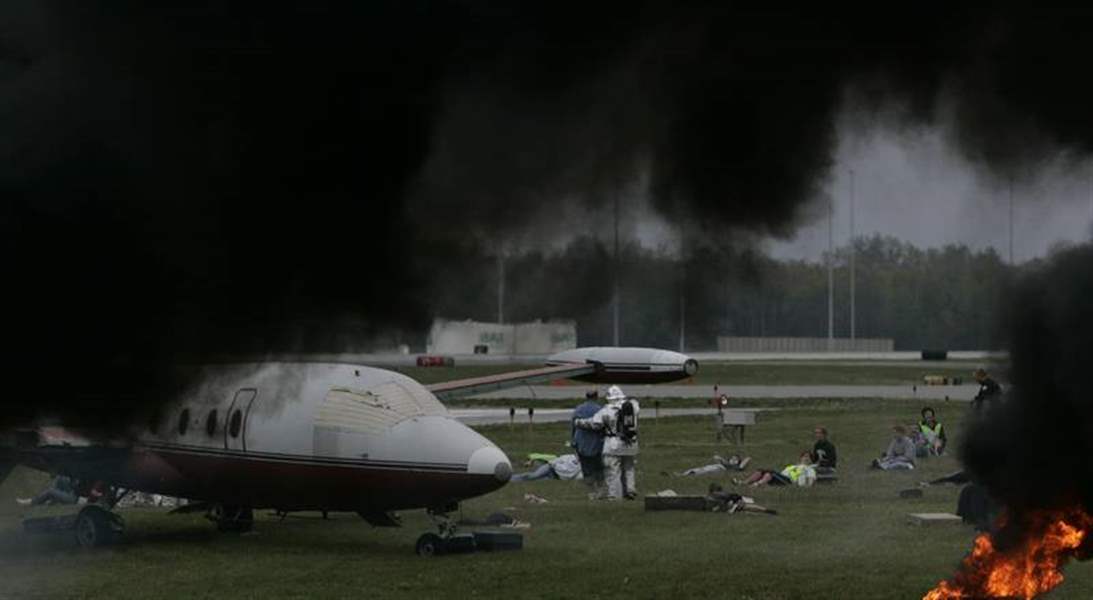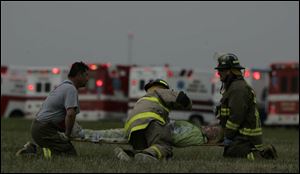
'Jet crash' is a realistic drill for emergency responders
5/2/2006
A pall of black smoke from diesel fires lends authenticity to this aircraft disaster drill at Toledo Express Airport. Rescue workers aid 'survivors' of a mock crash on the grass near a runway.

A pall of black smoke from diesel fires lends authenticity to this aircraft disaster drill at Toledo Express Airport. Rescue workers aid 'survivors' of a mock crash on the grass near a runway.
Ashley Pifer "survived" the mock airplane collision last night at Toledo Express Airport, but by the time rescue workers got to the 14-year-old Sylvania girl, she was "dead."
"It took them 45 minutes to get to me," Miss Pifer, a freshman at Sylvania Northview High School, said while huddling under a blanket with three other crash "victims" on the grass near the north end of the airport's Runway 34 yesterday evening.
But Mark Fisher, police chief for the Toledo-Lucas County Port Authority, said that if there were a real plane crash some day at the airport, it might indeed take a while for medical help to reach some of the injured - for starters, because fire crews first would need to make sure the scene was safe for rescuers to enter.
"It would take quite a while," Chief Fisher said while emergency responders from at least seven area departments plus the port authority's own firefighters extinguished test fires and carried "victims" away on backboards.
"You can't just go into a scene and start removing victims. It has to be orderly; otherwise, you'd have mass chaos," he said.
Under federal regulations, commercial airports are required to conduct disaster drills every three years, Airport Director Paul Toth said, although this was the first at Toledo Express since 1999 because of a mass casualty incident at the 2002 air show there. High heat felled more than 300 people at the air show, with about half going to hospitals and the rest receiving first aid at the airport.
The scenario for yesterday's drill was a crash involving a 10-passenger corporate jet whose landing gear failed upon landing, causing it to careen into a similar plane waiting on a taxiway near the runway.

Firefi ghters hone their skills during a disaster drill by practicing treating the injured.
The plan called for 20 people to act as victims, but at least twice that number of volunteers - drawn from firefighters' families, airport workers, and, in Miss Pifer's case, Theater Kids Inc. students - showed up. Many were painted up with stage makeup to simulate head injuries.
Some compromises from realism were inevitable. The sign on a lanyard said Vicki Zak, an airport security screener, had a broken neck, but that didn't stop her from moving out of the way when one of the airport fire trucks started shooting water toward her.
"It was realistic enough. They did a good job," Ms. Zak said after rescuers carried her on a backboard, held down by duct tape, to an ambulance.
And once the "dead" had been checked and tagged with black armbands, some of them couldn't help but chat and giggle amongst themselves - and take refuge under their blankets from rain showers that began during the drill.
"It was good until it started raining. Then it got cold," Miss Pifer said.
Grand Aire Inc. provided two aircraft for use during the drill, one of which it allowed to be cut up for search-and-rescue and extrication practice. Fires, set using vats of diesel fuel, were staged at several locations downwind from where the victims were scattered about on the grass.
Mr. Fisher said the primary purpose of disaster drills is to see how well a large number of emergency agencies can coordinate their efforts, and from what he could tell monitoring radio traffic, yesterday's exercise went pretty well.
A multi-agency critique likely will be held in a couple of weeks.
"The biggest thing in a disaster like this is communications, making sure everybody is getting the right information," the police chief said. "Even though people know it's a drill, when they see 'victims,' when they see fire, their hearts get pumping."
Contact David Patch at:
dpatch@theblade.com
or 419-724-6094.